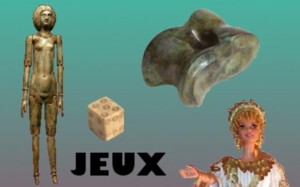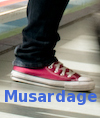« L’archéologie, c’est la recherche de notre histoire, de nos racines, et non pas la hantise égoïste de quelques amateurs de pots cassés », comme le disait mon maître, Michel Egloff. C’est dans cet esprit qu’avec le concours du blog be-virtual nous avons conçu et mis en ligne le calendrier de l’avent de cette année. Car il faut savoir qu’à côté de l’univers matériel des objets que l’on retrouve dans les couches archéologiques il y a un mode de vie qu’il faut pouvoir reconstituer et qui représente ce que l’on nomme depuis quelques années le patrimoine culturel immatériel. Sous l’égide de l’Unesco a été rédigée en 2003 une Convention pour la sauvegarde du patrimoine culturel immatériel. Elle est entrée en vigueur le 20 avril 2006 et a été ratifiée à ce jour par 104 états.

Extrait de la porte du 11 décembre illustrant les jeux
Le 30 septembre 2008 était la date limite de soumission de candidatures pour l’inscription sur la Liste représentative du patrimoine culturel immatériel de l’humanité. C’est l’année prochaine, lors de sa prochaine session, que le Comité intergouvernemental de sauvegarde du patrimoine culturel immatériel décidera quelles manifestations de la créativité humaine doivent être inscrites sur cette liste. Parmi les 90 éléments culturels représentatifs incorporés à la liste en novembre 2008, on y trouve des danses folkloriques, des chants traditionnels, des formes théâtrales, des musiques ancestrales, des carnavals historiques, des récits oraux immémoriaux, des savoir-faire artisanaux, des techniques divinatoires, et j’en passe. La survivance de ce patrimoine est à nos yeux importante pour notre pratique de l’archéologie car, à côté de la culture matérielle visible, ce patrimoine nous dévoile toute la richesse et l’universalité des manifestations de la pensée humaine qui peuvent lui être associée. Demain sera ouverte la dernière porte du calendrier de l’AVANT. J’espère que vous avez eu plaisir à découvrir ces témoignages comme nous avons eu plaisir à les réaliser.


1 user commented in " Avant le patrimoine immatériel "
Follow-up comment rss or Leave a TrackbackCountries that erase their own past can never maintain their existence in the future
The site of Allianoi is situated in the middle of a lake that will be formed by water being stored upstream of Yortanlı Dam. This dam has been constructed about 20 km northeast of the historical city of Bergama by the Turkish Government to provide irrigation water to downstream farmers.
During the past nine years, a dedicated team of archaeologists has been excavating the site of Allianoi. Over ten thousand artefacts have been transferred to Bergama museum. In 2006, this peaceful historical and cultural heritage site was opened up to visitors.
Allianoi, which is the Bergama region’s second 1800-year-old health centre, has revealed many historically rich monuments. One of the world’s best preserved and biggest Roman thermal spas has been found in Allianoi, where hot springs are still to be found. The site has yielded many important scientific insights in the fields of archaeology, art history, engineering, medicine, architecture, hydrology, and pharmacology.
Allianoi was designated as a heritage site of the first order by İzmir’s I. KTVK Committee in 2001. However, a great deal of pressure has been put upon this committee to change its decision. Despite this, up to October 2007, the committee has persistently resisted changing its first-order classification of the site.
In order to save Allianoi from being flooded, 35 000 signatures have been collected. During the years of 2005 and 2006, most of the written applications that were sent to the Turkish Minister of Culture were about the preservation of Allianoi.
Domestic and international
A number of conferences, panel discussions, exhibitions, concerts and shows have been organized about Allianoi. Over fifty books and articles have been published about the site.
Civil Community Organizations have instigated a number of court cases. These organizations have canvassed governmental officials to preserve Allianoi.
We have launched many court cases, and the AHIM court case is still ongoing.
In order to save Allianoi in a practical way, an alternative project was sent to the Turkish Government in 2002, but was rejected by the Minister of Culture because of its exorbitant cost estimate.
In order to cover up the intention of submerging the site within the academic sphere, the Turkish Minister of Culture established the First Academic Scientific Committee in 2005. This committee stressed the fact that submerging the area will not protect the cultural heritage site, and further emphasized that Allianoi should be included in the World Heritage List. However, the committee’s scientific report was concealed from the public.
A Second Academic Scientific Committee was established in 2006. This committee came up with six alternative proposals. It decided not to support submerging the site, and this decision was also concealed from the public.
In 2007, a Third Academic Scientific Committee was established by the Minister of Culture. The non-science committee members were taken to the excavation area without informing the science committee members. A report was prepared in accordance with the wishes of the bureaucrats. The decision to submerge the site was declared by the committee after presentation of the report to the preservation sub-committee within the same week. This game of “Scientific Committees” would have continued until the decision was made to demolish the site.
The committee that declared in March 2001 that a heritage site of the first order should be preserved from submergence showed its dilemma in October 2007 by presenting the spurious argument that covering the structures on the site with a layer of clay would preserve the site.
The Turkish Government continues to ignore the International Conventions that have already been ratified; moreover Turkey is also contravening its own Constitutional Law by submerging the site.
One of the most important of humankind’s common cultural heritage sites is going into the darkness of history without gaining any real knowledge about it.
Excavating the site after the lifespan of the dam has come to an end is the biggest lie of all, and nobody from academia will make this claim.
There is no cultural heritage site in the world that has been brought back into the history of humankind after descending below a dam’s inundation.
On the day when Turkey will decide to safeguard Allianoi for future generations, then she will demonstrate herself as a contemporary state which is relevant to the 21st century.
Do not let your future be buried in the sand. Do not let Allianoi be buried in mud!
Dr. Ahmet YARAŞ
Trakya Üniversitesi
Arkeoloji Bölümü
TR- 22100 EDİRNE
http://www.allianoi.org
mail: ahmetyaras@allianoi.org
Leave A Reply